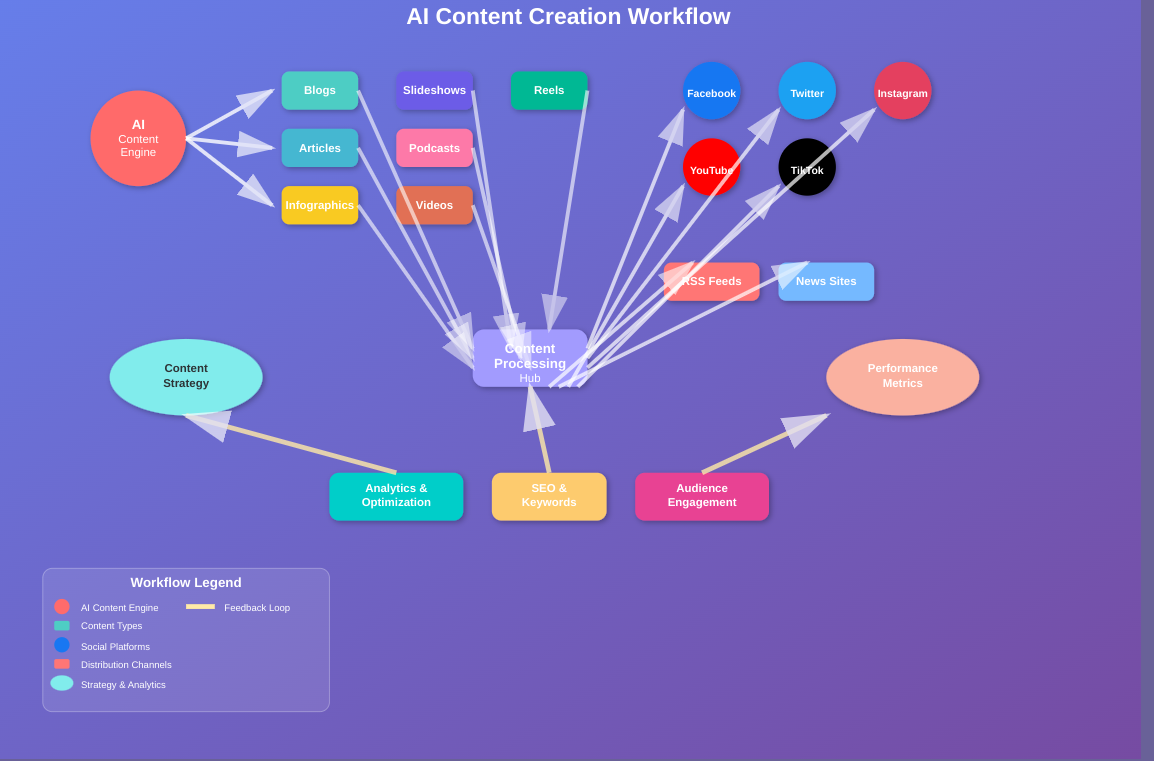Integrate AI into your content workflow to gain competitive advantages through enhanced efficiency, data-driven decisions, and personalization at scale. Companies using AI deliver more responsive, precise content while those hesitating risk falling behind as the digital marketplace evolves.
Read more AI driven content here: https://amzoraltd.com/the-role-of-artificial-intelligence-in-future-proofing-your-online-presence/
AI is Revolutionizing Content Creation Right Now
The content landscape has fundamentally changed. In today’s digital marketplace, speed, personalization, and data-driven decision making separate market leaders from the rest. AI integration isn’t just a fancy addition to content workflows—it’s now the fundamental difference between staying competitive and falling behind.
At Content Marketing Agent, we’ve seen how businesses transform their content operations through strategic AI implementation. The results are clear: organizations that use AI in their content workflows experience dramatic improvements in productivity, engagement metrics, and ultimately, business outcomes.
What makes AI so transformative for content creation isn’t just automation—it’s the combination of speed, intelligence, and adaptability that traditional processes simply cannot match. By analyzing vast amounts of data in real-time, AI systems can identify patterns, predict trends, and generate insights that would take human teams significantly longer to discover. This capability fundamentally changes what’s possible in content marketing.
The Critical Business Advantages of
AI-Enhanced Content Workflows
1. Dramatically Accelerated Content Production
AI tools fundamentally transform content production timelines. Tasks that once took days can now be completed in hours or even minutes. AI writing assistants can generate drafts, outlines, and variations at impressive speeds, while automated research tools gather and organize information from numerous sources simultaneously.
This acceleration means your team can produce more content without sacrificing quality, respond faster to market changes, and capitalize on trending topics before competitors. When breaking news affects your industry, AI-powered workflows enable you to publish thoughtful analyses while others are still gathering information.
2. Data-Driven Decision Making at Scale
Modern content strategy requires solid data. AI analyzes massive data sets to identify what your audience wants, which topics perform best, and how content should be structured for maximum impact. These insights enable truly data-driven decisions about content priorities and resource allocation.
With AI’s analytical capabilities, you can understand not just what content works, but why it works. This deeper understanding leads to more strategic content planning and consistently better results across campaigns.
3. Hyper-Personalization That Connects
Today’s consumers expect content that speaks directly to their specific needs, interests, and challenges. AI makes this level of personalization possible at scale by segmenting audiences with precision and tailoring content automatically for different segments.
AI can analyze user behavior patterns to determine what topics, formats, and messaging resonate with different audience segments. This enables the creation of content experiences that adapt to individual preferences, significantly increasing engagement and conversion rates.
4. Predictive Capabilities That Outpace Competitors
Reacting to market trends isn’t enough—AI gives you the power to anticipate them. Predictive analytics can forecast which topics will gain traction, which keywords will trend, and how audience interests will evolve. This foresight allows you to develop content that meets emerging needs before competitors even identify them.
By positioning your brand as a forward-thinking leader that addresses problems before they become widespread, you establish stronger authority in your space.
Learn the difference between predictive and descriptive AI analytics here: https://amzoraltd.com/predictive-vs-descriptive-ai-marketing-analytics-for-roi/
5. Reduced Operational Costs and Resource Allocation
AI doesn’t just make content creation faster—it makes it more cost-effective. By automating routine tasks like research, proofreading, and basic content generation, AI frees your creative team to focus on high-value activities that truly require human creativity and emotional intelligence.
This optimization of human resources leads to significant cost savings while simultaneously improving output quality. Teams spend less time on mechanical processes and more time on strategic thinking, creative development, and content refinement.

How AI Transforms Each Stage of Content Creation
1. Ideation and Topic Discovery
Finding compelling topics that resonate with audiences while supporting business goals is a persistent challenge. AI transforms this process by analyzing search trends, social media conversations, competitor content, and audience engagement patterns to identify high-potential topics and content gaps.
AI tools can suggest content ideas based on questions your audience is asking, topics gaining momentum in your industry, or opportunities your competitors have missed. This data-driven approach to ideation ensures your content strategy addresses genuine audience needs rather than assumed interests.
2. Research and Data Gathering
Comprehensive research underpins high-quality content, but it’s often time-consuming. AI research assistants can scan thousands of sources quickly, extracting relevant information, identifying key statistics, and organizing findings into usable formats.
These tools can verify facts, identify credible sources, and highlight contradictory information that requires further investigation. The result is more thorough research accomplished in less time, leading to more authoritative, accurate content.
3. Content Writing and Editing
AI writing tools have evolved significantly, now capable of generating everything from social media posts to long-form articles. These tools excel at creating first drafts, suggesting headlines, developing outlines, and offering alternative phrasing for unclear passages.
Advanced editing assistants enhance readability, ensure consistent tone, check facts, and optimize content for search engines. They can also help adapt content for different platforms while maintaining core messaging.
4. Visual Content Creation
Visual elements significantly impact content performance, but creating professional graphics has traditionally required specialized skills. AI design tools now enable teams to generate custom images, infographics, and videos without extensive graphic design expertise.
(Top AI design tool https://www.figma.com/ai/)
These tools can recommend visual styles based on brand guidelines, suggest layouts that optimize engagement, and even generate custom illustrations or modify stock photos to create unique visual assets. This democratization of design capabilities ensures your content stands out visually without requiring extensive design resources.
5. Distribution and Performance Analysis
Creating great content means little if it doesn’t reach the right audience. AI optimizes distribution by identifying the best channels, timing, and promotion strategies for each piece of content. It can automatically adjust publishing schedules based on real-time engagement data and audience availability patterns.
Once content is published, AI analytics tools track performance across multiple metrics, providing actionable insights for improvement. These tools can identify which elements of your content drive engagement and which might be undermining success, enabling continuous optimization.
Implementation
Challenges and
Practical Solutions
1. Maintaining Content Authenticity
As AI becomes more integral to content creation, maintaining an authentic brand voice can be challenging. AI-generated content can sometimes feel generic or lack the nuanced understanding of your brand’s unique perspective.
Solution: Develop detailed brand voice guidelines for AI tools and implement a human review process for all AI-generated content. Use AI as a collaborative partner rather than a replacement—let it handle first drafts and research, while human creators refine messaging and inject authentic perspectives. The most successful approaches use AI to amplify human creativity, not replace it.
2. Finding the Human-AI Balance
Determining which tasks should be automated and which require human touch is a critical implementation challenge. Over-automation can lead to content that feels mechanical, while under-utilization of AI limits efficiency gains.

Solution: Start by mapping your content workflow and identifying specific points where AI can add the most value—typically repetitive, data-heavy, or time-consuming tasks. Reserve human effort for strategy, emotional storytelling, and final quality control. This balanced approach ensures you capture efficiency gains without sacrificing the creative spark that makes your content compelling.
3. Addressing Ethical Considerations
AI systems reflect the data they’re trained on, which can include biases or inaccuracies. Ensuring ethical use of AI in content creation requires vigilance.
Solution: Establish clear ethical guidelines for AI usage, including fact-checking protocols and bias detection processes. Implement oversight mechanisms to verify AI outputs against your brand’s values and factual standards. Regularly audit AI-generated content for unintentional biases or problematic patterns.
4. Selecting the Right AI Tools for Your Needs
The market is filled with AI content tools, each promising powerful capabilities. Choosing the right solutions for your specific needs can be challenging.
Solution: Begin with a careful assessment of your content workflow pain points and objectives. Prioritize tools that address your most significant challenges first. Look for solutions with proven track records and robust integration capabilities with your existing tech stack. Consider starting with smaller pilot projects before full-scale implementation to evaluate real-world performance.
The Future-Proof
Content Strategy Starts with AI Today
The content field continues to change rapidly, with consumer expectations rising and competition intensifying across all channels. Organizations that delay AI integration face an increasingly steep uphill battle as competitors use these technologies to create more content, with greater personalization, at lower costs.
Starting your AI integration journey now provides several critical advantages:
- Experience Curve Benefits: Early adopters gain valuable experience with AI tools and workflows, allowing them to optimize processes while competitors are still in the experimentation phase.
- Data Advantage: AI systems improve with data and usage. The sooner you implement these tools, the more time they have to learn your brand voice, audience preferences, and performance patterns.
- Talent Development: Your team develops valuable AI collaboration skills that will become increasingly necessary as these technologies become standard across the industry.
- Incremental Implementation: Beginning now allows for measured, strategic implementation rather than rushed adoption when competitive pressures make AI integration unavoidable.
The most effective approach to AI integration follows these principles:
- Start small with specific use cases where AI can demonstrate clear value
- Measure results rigorously against pre-implementation benchmarks
- Gather feedback from both content creators and audiences Iterate constantly to refine your AI implementation
- Expand gradually to additional workflow areas as you build expertise
By thoughtfully integrating AI into your content workflow today, you position your organization to not merely keep pace with the changing digital field but to lead it. You’ll create more engaging content, deliver it more efficiently, and continuously optimize based on deeper insights than previously possible.
The question is no longer whether to integrate AI into your content workflow, but how quickly and effectively you can use these powerful tools to gain and maintain your competitive advantage.
Content Marketing Agent specializes in helping organizations seamlessly integrate AI solutions into their content workflows for maximum competitive advantage.
Key Takeaways
- AI integration in content workflows delivers significantly greater efficiency, precision, and responsiveness
- Businesses using AI-powered content strategies gain critical market advantages through deeper customer insights and data-driven decision making
- Content personalization at scale becomes possible through AI-driven processes, leading to higher engagement rates
- Content Marketing Agent helps organizations seamlessly integrate AI into existing content operations
- Companies that fail to adopt AI in their content strategies risk falling behind competitors



Pingback: Marketing AI Integration Challenges with Solutions Guide